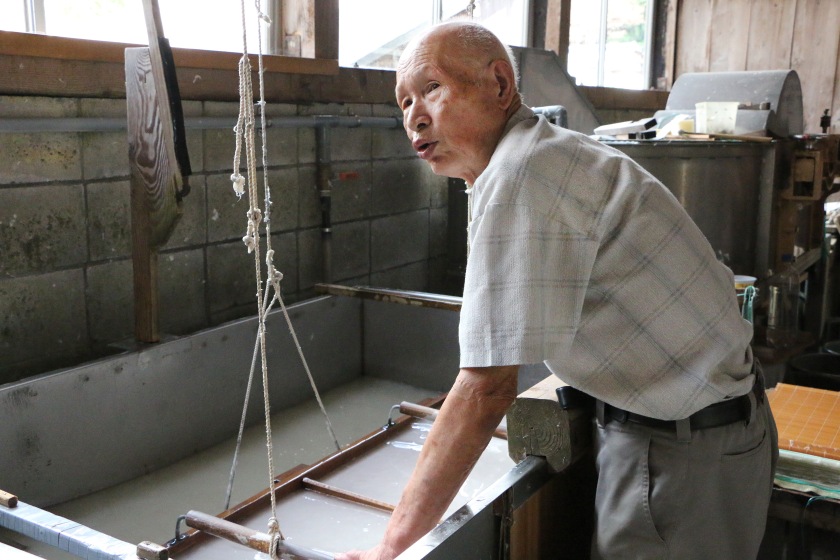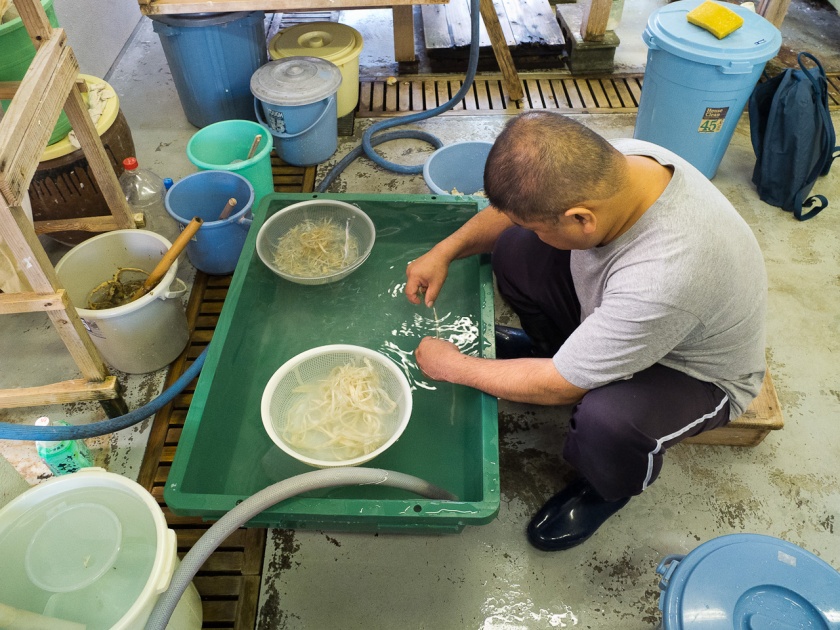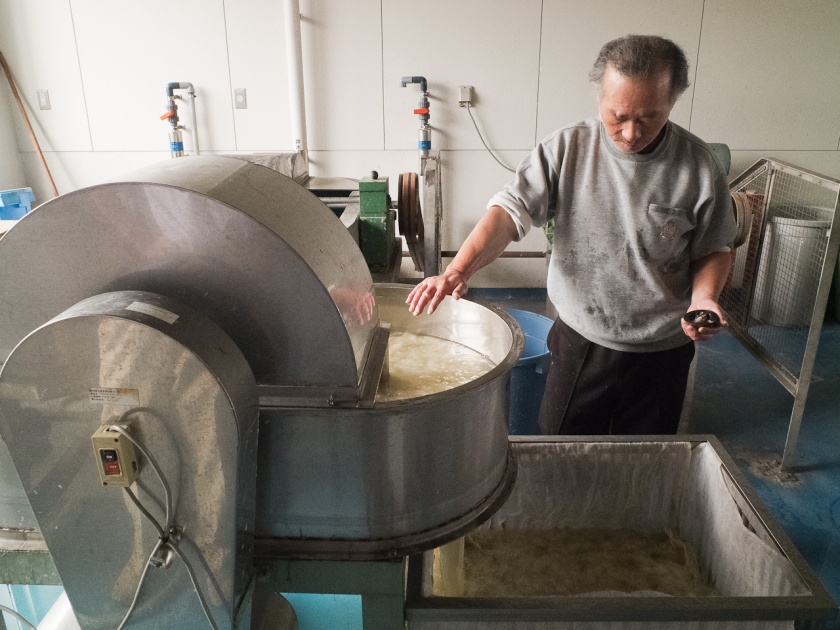Above, the Yoshino river, with its pebbled edges, flows elegantly through Nara, where our Uda Gami and Nara Natural Dyed paper series are made. (pic: Yukako Ando)
Every two years, Hiromi Paper staff lead a tour through Japan visiting papermakers, toolmakers, and conservationists to gain further understanding of the world of Washi. The tour is heavily focused on conservation, thus we visit mostly the artisans who are producing papers used for conservation and restoration. As usual, the tour began in Kyoto, then traveled on a chartered bus through Japan visiting prefectures like Kochi, Shimane, Fukui, Gifu, and Nara. Participants stay in nearby accommodations and eat what is locally available. During the tour the artisans show how they are making the papers that many of our customers have come to know so well. Here, HPI staff Yuka presents what she saw and what she heard during this year’s tour.
Washi was not made in the summer because the tororoaoi (neri) would lose its viscosity…
In a lightly air-conditioned traditional Japanese house, with the back and forth motion of rocking the suketa (papermaking mould), traditional handmade Japanese paper is made.

The light that shines through the studio windows are ever so warm and subtle, glistening on the water surface. The well water is cold to the touch. Inside the vat are the soft kozo fibers, floating in a solution of tororoaoi and water. The papermaking studios are quiet and calming, and draws us in.
Contrary to the stillness of the studio, the scorching sun continues to heat up the outdoors, with an uncontrollable amount of sweat rushing out. This year’s Hiromi Paper Washi Tour took place in the lingering summer heat, for seven days in the beginning of September. We visited six regions, twelve studios, and four paper museums.

The hot summertime is an ideal time for papermakers to accept visitors, due to the lack of papermaking work (papermaking is primarily done in the cold months), but the participants and Hiromi Paper staff felt as if we were all on a summer camp, battling the heat and humidity, unique to Japanese summers.
Upon visiting six different regions and twelve studios, I realized that there were various styles in papermaking. The preparation work, materials used, how the suketa (papermaking screen/mould) is moved, how the papers are dried, are all a bit different depending on the region. Due to this slight variation, it’s not possible to simply group “washi” into one category.
Each papermaker or region’s unique papermaking style has been passed down for generations and will be passed onto future generations as well.


THE YOUNG GENERATION ALSO HARD AT WORK



IN BETWEEN THE OLD AND YOUNG GENERATION ARE: Hiroyoshi Chinzei of Hidaka Washi, Kiyoko Urabe making Usu Mino paper, Masayuki Fukunishi of Uda-gami, Uekubo san of Hon Misu gami, and Norimasa Abe making Izumo Mingei paper.





I don’t want to reveal what the subtle differences in papermaking styles are just yet, but perhaps you’d like to consider finding out for yourself on the next Washi Tour…?
Supported by the presence of beautiful mountains and natural water, there is great significance and depth in the traditions of papermaking, passed down from generations past. To meet the people that make the papers and to learn about the backstory is helpful in becoming one step closer to washi. I am grateful to all of the papermakers and craftsmen that I met throughout the tour, and wish them all the best in their future endeavors.


Washi Tour Route: Tosa Washi Museum / Hamada Washi (handmade Tengucho) / Hidaka
Washi (machine-made Tengucho) / Mr. Yamaomto (Japanese papermaking tool maker) /
SHIMANE: Abe Eishiro Memorial Hall / Shinichiro and Norimasa Abe (Izumo Mingei
papermaker) / Otaki Shrine (Paper shrine) / Iwano Paper Mill (large-sie handmade papermaker)/ Yamaki Seishi (Gampi papermaker) / Ichibei Iwano (National Living Treasure) / Igarashi Paper Mill (large-size handmade papermaker) / Kiyoko Urabe (Usu Mino papermaker) / Mino Washi Museum / Masayuki Fukunishi (Yoshino Uda-gami papermaker) / Ryoji Uekubo (Hon Misu papermaker) / Mr. Sekichi of Bokusendo (Conservation studio)
For more information about our Biannual Washi Tour, email washi@hiromipaper.com.
ALL IMAGES ARE COPYRIGHT HIROMI PAPER, INC. For use of images you can inquire at washi@hiromipaper.com. All photos taken by Yukako Ando.
















 (Since most of the papermakers did not allow us to take pictures because of their machines, the pictures are a bit limited).
(Since most of the papermakers did not allow us to take pictures because of their machines, the pictures are a bit limited).





